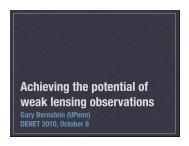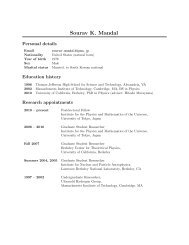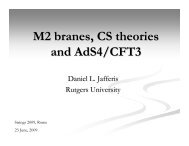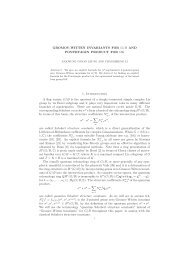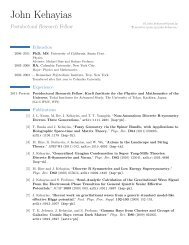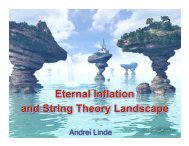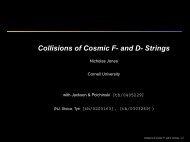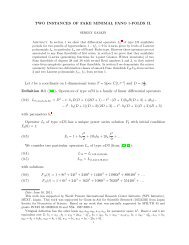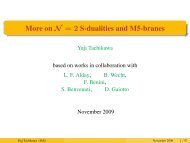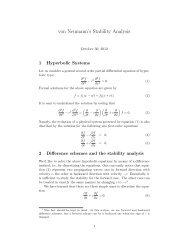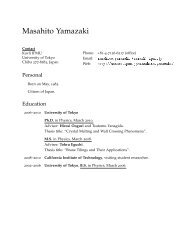STUDY SUMMARY - IPMU
STUDY SUMMARY - IPMU
STUDY SUMMARY - IPMU
Create successful ePaper yourself
Turn your PDF publications into a flip-book with our unique Google optimized e-Paper software.
<strong>SUMMARY</strong> REPORT<br />
WIDE FIELD FIBER-FED OPTICAL<br />
MULTI-OBJECT SPECTROMETER (WFMOS)<br />
rable. In a survey spanning 4 × 10 6 galaxies, this component of our dark energy survey will<br />
measure the acoustic scale to about 0.7% precision in this redshift range.<br />
Ahead of a potential JDEM/Euclid mission whose launch can be expected in ~2018–2020,<br />
WFMOS will have no competition in the two proposed redshift ranges from any facility. The<br />
only possible competitor is the HETDEX project, which plans to survey Lyman α emitters in a<br />
blind manner in the z > 3 regime. If that survey proceeds, our high-redshift survey would still be<br />
valuable, complementing HETDEX by focusing on a different population of continuum-selected<br />
sources.<br />
In summary, the proposed combination of galaxy surveys discussed in this proposal will:<br />
• Measure the equation of state of dark energy using BAO over 0.7 < z < 1.6 to a precision<br />
of 3% on constant w, better than the precision achieved by BOSS at lower redshift<br />
z < 0.8.<br />
• Measure the evolution parameter, w a , to a precision of approximately 0.3 (combining<br />
with Planck and existing supernova data), offering an interesting test of possible<br />
departures from a cosmological constant w = –1 over 0 < z < 2. This represents a DETF<br />
figure of merit of close to 100, about 1.7 times better than expected from BOSS with the<br />
same assumptions.<br />
• Measure the growth rate f g (z) over 0.7 < z < 3.3 with unprecedented precision to test for<br />
departures from Einstein gravity. The 0.7< z < 1.6 survey alone would measure f g to<br />
about 1.5% precision offering the first convincing test of the standard model. The 2.5 < z<br />
< 3.3 survey would add a second constraint over a larger time baseline to 7%.<br />
As discussed in detail in the OCDD, the 0.7 < z < 1.6 BAO/RSD survey will target 4×10 6<br />
color-selected galaxies to R AB < 23.0 over a survey area of 3,200 deg 2 . Using the Keck DEEP2<br />
survey data as a test case, we have developed techniques using BRI photometry that ensure a<br />
high success rate not only in selecting sources that lie in the required redshift range but also in<br />
indicating the sources likely to show strong [O II] emission, thus significantly improving the<br />
survey efficiency. Many ongoing and planned imaging surveys (DES, PanSTARRS, KIDS—in<br />
which our team’s institutions are involved) will yield a photometric redshift accuracy better than<br />
that based on BRI photometry. The key issue is to ensure these surveys are sufficiently deep and<br />
located in an appropriate part of the sky for WFMOS with sufficient area. The simplest route is<br />
to augment the HSC weak lensing survey (likely ~2,000 deg 2 ) with DES, KIDS or Pan-STARRs<br />
data. Additional HSC imaging will not likely be required (see OCDD for discussion). Spectroscopic<br />
completeness is not a concern provided the survey is uniformly selected over a large cosmic<br />
volume. With exposure times of 15 minutes and minimal reconfiguration overheads, this<br />
survey is expected to require 832 clear Subaru hours (~83 nights). 2<br />
The 2.5 < z < 3.3 RSD survey will target 100,000 galaxies to R AB < 25 over a survey area of<br />
100 deg 2 . Targets will be found using well-tested ugr Lyman break selection methods. gr (or<br />
equivalent) imaging data will be readily available from the HSC weak lensing survey; the more<br />
challenging need is deep u-band data. Fortunately, the CFHT Legacy Survey has already obtained<br />
a significant (150 deg 2 ) amount of u-band data with adequate depth. Some is already public,<br />
and no doubt the remainder will be in a few years’ time. With spectroscopic exposure times<br />
of 4 hours, the high-redshift survey will require 286 clear Subaru hours (~29 clear nights).<br />
Thus, in summary, the dark energy/modified gravity campaign can be accomplished in ap-<br />
2 We adopt the Gemini-recommended unit that 1 night = 10 hours<br />
10



